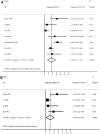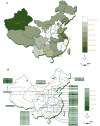The tip of the "celiac iceberg" in China: a systematic review and meta-analysis
- PMID: 24324669
- PMCID: PMC3852028
- DOI: 10.1371/journal.pone.0081151
The tip of the "celiac iceberg" in China: a systematic review and meta-analysis
Abstract
Objective: Until recently, celiac disease was considered to be rare in China. We aimed to estimate its true status.
Methods: By searching the MEDLINE database and four Chinese full-text databases (CNKI, CBM, VIP and WANFANG) (up to August 2012), as well as two HLA allele frequency net databases and the Chinese Statistics Yearbook databases, we systematically reviewed the literature on definite and suspected cases of celiac disease, the predisposing HLA allele frequencies, and on gluten exposure in China. Meta-analysis was performed by analyzing DQ2, DQ8 and DQB1*0201 gene frequencies and heterogeneity in populations from different geographic regions and ethnicities in China.
Results: At present, the number of reported celiac disease cases is extremely low in China. The frequencies of the HLA-DQ2.5 and HLA-DQ8 haplotypes were 3.4% (95% confidence interval 1.3-5.5%) and 2.1% (0.1-4.1%), respectively. HLA-DQ2 and HLA-DQ8 antigen frequencies were 18.4% (15.0-21.7%) and 8.0% (4.5-11.4%), respectively. The frequency of the DQB1*0201 allele was 10.5% (9.3-11.6%) and it was more common in the northern Chinese than in the southern Chinese populations. The chance of being exposed to gluten is rapidly increasing all over China nowadays.
Conclusion: The data on HLA haplotyping, in conjunction with increasing wheat consumption, strongly suggests that the occurrence of celiac disease is more common in China than currently reported. Coordinated measures by the Chinese government, medical and agricultural research institutions, and food industries, would be justified to create more awareness about celiac disease and to prevent it becoming a medical and societal burden.
Conflict of interest statement
Figures






Similar articles
-
Association between human leukocyte antigen class II-DR-DQ and narcolepsy: a case control study.J Clin Sleep Med. 2024 Dec 1;20(12):1945-1953. doi: 10.5664/jcsm.11300. J Clin Sleep Med. 2024. PMID: 39150697
-
Inflammatory Myopathies and Autoimmune Gluten-related Disorders: A Scoping Review of Pathophysiological Interconnections and Hypothesis.Recent Adv Inflamm Allergy Drug Discov. 2025;19(2):221-235. doi: 10.2174/0127722708317244240919113305. Recent Adv Inflamm Allergy Drug Discov. 2025. PMID: 39665304 Free PMC article.
-
Gluten-Associated Medical Problems.2025 Jun 20. In: StatPearls [Internet]. Treasure Island (FL): StatPearls Publishing; 2025 Jan–. 2025 Jun 20. In: StatPearls [Internet]. Treasure Island (FL): StatPearls Publishing; 2025 Jan–. PMID: 30860740 Free Books & Documents.
-
Association of HLA class I and II genes with cutaneous leishmaniasis: a case control study from Sri Lanka and a systematic review.BMC Infect Dis. 2016 Jun 14;16:292. doi: 10.1186/s12879-016-1626-8. BMC Infect Dis. 2016. PMID: 27301744 Free PMC article.
-
Association of human leukocyte antigen (HLA)-DQ and HLA-DQA1/DQB1 alleles with Vogt-Koyanagi-Harada disease: A systematic review and meta-analysis.Medicine (Baltimore). 2018 Feb;97(7):e9914. doi: 10.1097/MD.0000000000009914. Medicine (Baltimore). 2018. PMID: 29443768 Free PMC article.
Cited by
-
Epidemiological, clinical, and histological presentation of celiac disease in Northwest China.World J Gastroenterol. 2022 Mar 28;28(12):1272-1283. doi: 10.3748/wjg.v28.i12.1272. World J Gastroenterol. 2022. PMID: 35431514 Free PMC article.
-
HLA-DQ genetics in children with celiac disease: a meta-analysis suggesting a two-step genetic screening procedure starting with HLA-DQ β chains.Pediatr Res. 2018 Mar;83(3):564-572. doi: 10.1038/pr.2017.307. Epub 2018 Jan 17. Pediatr Res. 2018. PMID: 29244800
-
Celiac disease: a disorder emerging from antiquity, its evolving classification and risk, and potential new treatment paradigms.Gut Liver. 2015 Jan;9(1):28-37. doi: 10.5009/gnl14288. Gut Liver. 2015. PMID: 25547088 Free PMC article. Review.
-
Celiac Disease Genetics, Pathogenesis, and Standard Therapy for Japanese Patients.Int J Mol Sci. 2023 Jan 20;24(3):2075. doi: 10.3390/ijms24032075. Int J Mol Sci. 2023. PMID: 36768398 Free PMC article. Review.
-
Pediatric Celiac Disease in Central and East Asia: Current Knowledge and Prevalence.Medicina (Kaunas). 2019 Jan 12;55(1):11. doi: 10.3390/medicina55010011. Medicina (Kaunas). 2019. PMID: 30642036 Free PMC article. Review.
References
-
- Green PHR, Cellier C (2009) Celiac disease. NEngl Med 357: 1731–1743. - PubMed
-
- World Gastroenterology Organisation (2012) World Gastroenterology Organisation Global Guidelines: Celiac disease. Available: www.worldgastroenterology.org/assets/export/userfiles/2012_Celiac%20Dise.... Accessed 12 July 2013.
-
- Romanos J, van Diemen CC, Nolte IM, Trynka G, Zhernakova A, et al.. (2009) Analysis of HLA and non-HLA alleles can identify individuals at high risk for celiac disease. Gastroenterology 137: : 834–840, 840.e1–3. - PubMed
-
- Ivarsson A, Hernell O, Stenlund H, Persson LA (2002) Breast-feeding protects against celiac disease. Am J Clin Nutr 75: 914–921. - PubMed
-
- Romanos J, Wijmenga C (2010) Predicting susceptibility to celiac disease by genetic risk profiling. Annals of Gastroenterology & Hepatlogy 1: 1–9.
Publication types
MeSH terms
Substances
LinkOut - more resources
Full Text Sources
Other Literature Sources
Medical
Research Materials

